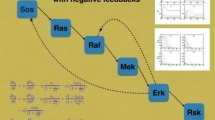Abstract
In animal cells, the transcription factor NF-\(\kappa \)B regulates many stressful, inflammatory, and innate immune responses. Experiments have revealed that, in response to cell stimulation, NF-\(\kappa \)B can exhibit oscillatory dynamics where the nature of these dynamics can influence the pattern of NF-\(\kappa \)B-dependent gene expression. Oscillations in NF-\(\kappa \)B are believed to depend on a negative feedback loop linking NF-\(\kappa \)B and one of its downstream products, namely \(\hbox {I}\kappa \hbox {B}\alpha \). This negative feedback loop is enhanced by cell stimulation. However, it also exists in the absence of cell stimulation. Here we propose a minimal spatio-temporal model of the NF-\(\kappa \)B signalling pathway, composed of partial differential equations. Through numerical simulations, we find various combinations of behaviours before and during cell stimulation: equilibrium dynamics (rapid convergence to a solution that is everywhere constant) before cell stimulation, followed by oscillatory dynamics during cell stimulation; oscillatory dynamics before and during cell stimulation; oscillatory dynamics before cell stimulation, followed by equilibrium dynamics during cell stimulation; and equilibrium dynamics before and during cell stimulation. In each case, when cell stimulation ceases, the model quickly returns to its pre-stimulation behaviour. All of these different combinations of behaviours occur for similar sets of parameter values. Therefore, our results may help to explain why, in experiments on the NF-\(\kappa \)B pathway involving populations of cells, only a certain fraction of the cells exhibit oscillatory dynamics.









Similar content being viewed by others
References
Alberts B, Johnson A, Lewis J, Raff M, Roberts K, Walter P (2008) Molecular biology of the cell, 5th edn. Garland Science, Taylor and Francis Group, LLC
Morgan MJ, Liu Z (2011) Crosstalk of reactive oxygen species and NF-\(\kappa \)B signaling. Cell Res 21:103–115
Weinberg R (2007) The biology of cancer. Garland Science, Taylor and Francis Group
Hoffmann A, Levchenko A, Scott M, Baltimore D (2002) The I\(\kappa \)B-NF-\(\kappa \)B signaling module: temporal control and selective gene activation. Science 298:1241–1245
Nelson DE, Ihekwaba AE, Elliott M, Johnson JR, Gibney CA, Foreman BE, Nelson G, See V, Horton CA, Spiler DG, Edwards SW, McDowell HP, Unitt JF, Sullivan E, Grimley R, Benson N, Broomhead D, Kell DB, White MR (2004) Oscillations in NF-\(\kappa \)B signaling control the dynamics of gene expression. Science 306:704–708
Ashall L, Horton C, Nelson D, Paszek P, Harper C, Sillitoe K, Ryan S, Spiller D, Unitt J, Broomhead D, Kell D, Rand D, See V, White M (2009) Pulsatile stimulation determines timing and specificity of NF-\(\kappa \)B-dependent transcription. Science 324:242–246
Krishna S, Jensen MH, Sneppen K (2006) Minimal model of spiky oscillations in NF-\(\kappa \)B. Proc Natl Acad Sci USA 103:10840–10845
Cheong R, Hoffmann A, Levchenko A (2008) Understanding NF-\(\kappa \)B signaling via mathematical modeling. Mol Syst Biol 4(192)
Terry AJ, Chaplain MAJ (2011) Spatio-temporal modelling of the NF-\(\kappa \)B signalling pathway: the roles of diffusion, active transport, and cell geometry. J Theor Biol 290:7–26
Basak S, Behar M, Hoffmann A (2012) Lessons from mathematically modeling the NF-\(\kappa \)B pathway. Immunol Rev 246:221–238
Sun S-C, Ganchi PA, Ballard DW, Greene WC (1993) NF-\(\kappa \)B controls expression of inhibitor I\(\kappa \)B\(\alpha \): evidence for an inducible autoregulatory pathway. Science 259:1912–1915
Lipniacki T, Paszek P, Brasier AR, Luxon B, Kimmel M (2004) Mathematical model of NF-\(\kappa \)B regulatory module. J Theor Biol 228:195–215
Pando MP, Verma IM (2000) Signal-dependent and -independent degradation of free and NF-\(\kappa \)B-bound I\(\kappa \)B\(\alpha \). J Biol Chem 275:21278–21286
Terry AJ, Sturrock M, Dale JK, Maroto M, Chaplain MAJ (2011) A spatio-temporal model of Notch signalling in the zebrafish segmentation clock: conditions for synchronised oscillatory dynamics. PLoS One 6(2):e16980
Sturrock M, Terry AJ, Xirodimas DP, Thompson AM, Chaplain MAJ (2011) Spatio-temporal modelling of the Hes1 and p53-Mdm2 intracellular signalling pathways. J Theor Biol 273:15–31
Puszynski K, Bertolusso R, Lipniacki T (2009) Crosstalk between p53 and NF-\(\kappa \)B systems: pro- and anti-apoptotic functions of NF-\(\kappa \)B. IET Syst Biol 3:356–367
Cangiani A, Natalini R (2010) A spatial model of cellular molecular trafficking including active transport along microtubules. J Theor Biol 267:614–625
Weiss M, Hashimoto H, Nilsson T (2004) Anomalous protein diffusion is a measure for cytoplasmic crowding in living cells. Biophys J 87:3518–3524
Ohshima D, Inoue J, Ichikawa K (2012) Roles of spatial parameters on the oscillation of nuclear NF-\(\kappa \)B: computer simulations of a 3D spherical cell. PLoS One 7(10):e46911
Loewer A, Batchelor E, Gaglia G, Lahav G (2010) Basal dynamics of p53 reveal transcriptionally attenuated pulses in cycling cells. Cell 142:89–100
Mahaffy JM, Pao CV (1984) Models of genetic control by repression with time delays and spatial effects. J Math Biol 20:39–57
Busenberg S, Mahaffy JM (1985) Interaction of spatial diffusion and delays in models of genetic control by repression. J Math Biol 22:313–333
Mahaffy JM (1988) Genetic control models with diffusion and delays. Math Biosci 90:519–533
Acknowledgments
This work was supported by the ERC Advanced Investigator Grant 227619, “M5CGS—From Mutations to Metastases: Multiscale Mathematical Modelling of Cancer Growth and Spread”.
Author information
Authors and Affiliations
Corresponding author
Electronic supplementary material
Below is the link to the electronic supplementary material.
Rights and permissions
About this article
Cite this article
Terry, A.J. A Minimal Spatio-Temporal Model of the NF-\(\kappa \)B Signalling Pathway Exhibits a Range of Behaviours. Bull Math Biol 76, 2363–2388 (2014). https://doi.org/10.1007/s11538-014-0011-2
Received:
Accepted:
Published:
Issue Date:
DOI: https://doi.org/10.1007/s11538-014-0011-2
Keywords
- NF-\(\kappa \)B
- Genetic oscillator
- Spatio-temporal model
- Negative feedback
- Gene regulatory network
- Cancer




